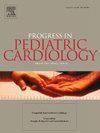Review of cardiovascular complications in children with sickle cell disease
IF 0.8
Q4 PEDIATRICS
引用次数: 0
Abstract
Background
Cardiovascular complications in pediatric patients with sickle cell disease may be life-threatening.
Aim of review
The purpose of this article is to review cardiovascular problems associated with sickle cell disease in children and adolescents, including pathophysiology, clinical presentation, diagnosis, and treatment.
Key scientific concepts of review
Sickle cell disease is a hemoglobinopathy that causes red blood cell sickling and vaso-occlusive crises. Chronic anemia may cause high-output cardiac failure. Other cardiovascular abnormalities include pulmonary hypertension, increased tricuspid regurgitation velocity, increased right ventricular pressure, cardiomyopathy with left ventricular hypertrophy and dysfunction, and increased risk of myocardial infarction, dysrhythmia, and sudden cardiac death. Patients may have chronic hemolytic anemia, red blood cell sickling, vaso-occlusive crises, and cardiovascular symptoms including chest pain, palpitations, shortness of breath, and fatigue. Cardiovascular complications also may include stroke, acute renal failure, and priapism. Diagnosis includes family history and diagnostic tests such as complete blood count, electrocardiography, echocardiography, chest radiography, and pulmonary function tests. Treatment of sickle cell disease may include hydroxyurea and treatment of complications, including pain from vaso-occlusive crises and cardiovascular disease. Early detection and intervention are important to limit sequelae of cardiovascular complications, and regular cardiovascular screening in pediatric patients with sickle cell disease is recommended.
儿童镰状细胞病心血管并发症综述
儿童镰状细胞病患者的心血管并发症可能危及生命。本文的目的是回顾与儿童和青少年镰状细胞病相关的心血管问题,包括病理生理、临床表现、诊断和治疗。评述的关键科学概念镰状细胞病是一种导致红细胞镰状和血管闭塞危象的血红蛋白病。慢性贫血可引起高输出量心力衰竭。其他心血管异常包括肺动脉高压、三尖瓣反流速度增加、右心室压力增加、心肌病伴左心室肥厚和功能障碍、心肌梗死、心律失常和心源性猝死的风险增加。患者可能有慢性溶血性贫血、红细胞镰状坏死、血管闭塞危象和心血管症状,包括胸痛、心悸、呼吸短促和疲劳。心血管并发症还可能包括中风、急性肾功能衰竭和勃起功能亢进。诊断包括家族史和诊断检查,如全血细胞计数、心电图、超声心动图、胸片和肺功能检查。镰状细胞病的治疗可能包括羟基脲和并发症的治疗,包括血管闭塞危象和心血管疾病引起的疼痛。早期发现和干预对于限制心血管并发症的后遗症非常重要,建议镰状细胞病患儿定期进行心血管筛查。
本文章由计算机程序翻译,如有差异,请以英文原文为准。
求助全文
约1分钟内获得全文
求助全文
来源期刊

PROGRESS IN PEDIATRIC CARDIOLOGY
PEDIATRICS-
CiteScore
0.90
自引率
11.10%
发文量
69
审稿时长
75 days
期刊介绍:
Progress in Pediatric Cardiology is an international journal of review presenting information and experienced opinion of importance in the understanding and management of cardiovascular diseases in children. Each issue is prepared by one or more Guest Editors and reviews a single subject, allowing for comprehensive presentations of complex, multifaceted or rapidly changing topics of clinical and investigative interest.
 求助内容:
求助内容: 应助结果提醒方式:
应助结果提醒方式:


